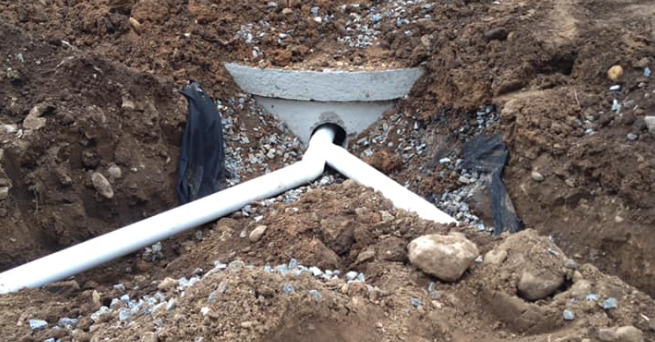Drainage
Three primary drainage techniques are used in site work: surface, horizontal subsurface, and vertical. Each of these methods serves a specific purpose and contributes to the overall effectiveness of the drainage system.
3 Main Types
Surface Drainage
Surface drainage is the most visible and straightforward form. It directs water away from the site’s surface, utilizing gravity to ensure proper flow. The main components of surface drainage include channels, ditches, and gutters that collect and transport water.
These features are designed strategically to intercept and redirect runoff, preventing it from pooling and causing damage. This type is particularly effective in managing stormwater and preventing water accumulation on roads, driveways, and other paved surfaces.
Horizontal Subsurface Drainage
Horizontal subsurface drainage, or French drains, tackles water infiltration issues below the ground surface. This method involves horizontally installing perforated pipes or tiles to collect and redirect groundwater. The lines are typically surrounded by a gravel or crushed stone layer, which acts as a filter and facilitates water flow.
Horizontal subsurface is commonly used in areas with high groundwater levels or poor soil permeability. It helps to alleviate hydrostatic pressure, prevent soil saturation, and stabilize the subsoil, thus protecting structures from potential damage.
Vertical Subsurface Drainage
Vertical subsurface drainage controls water table levels and manages excess groundwater. This technique involves the installation of deep wells or boreholes, which are connected to a network of perforated pipes or drainage tiles. The lines collect water from the surrounding soil and direct it to the well, pumped out and discharged from the site.
Vertical subsurface is beneficial in areas with a high water table or where the soil cannot absorb water. It helps to maintain stability, prevent flooding, and protect foundations and underground structures from water-related issues.
Why Choose Stewart Builders
Stewart Builders’ team of experts initiates the proper design and installation of these systems to ensure their effectiveness. Factors such as site topography, soil composition, and anticipated water flow patterns are carefully considered.
We must combine these three techniques to create a comprehensive and efficient system to effectively manage water on construction sites. While surface drainage addresses immediate water removal from the site’s surface, horizontal subsurface and vertical tackle deeper infiltration and groundwater issues.

4 Drainage Patterns
This pattern resembles the branches of a tree and is used where the river channel follows the slope of the terrain.
This pattern is used when rivers meet at right angles and where soft and hard rocks exist parallel to each other.
This pattern is created when there is a strong jointed rocky terrain.
When streams have a central point and than flow out in different directions.
Contact Us For Services
